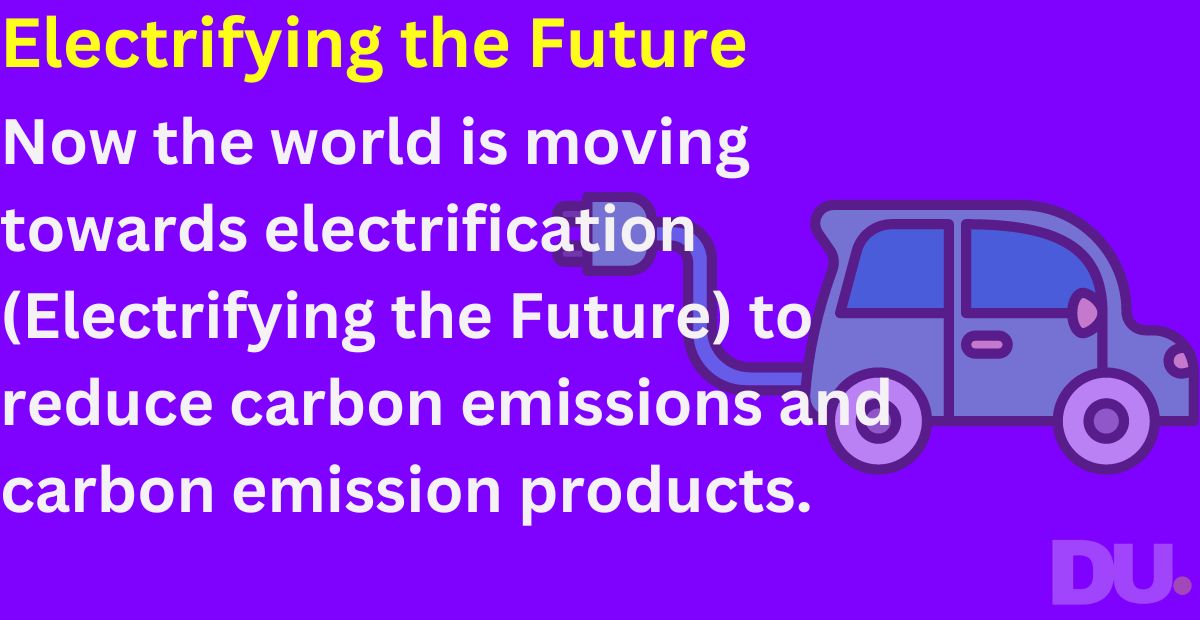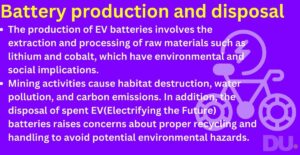Introduction
Now the world is moving towards electrification (Electrifying the Future) to reduce carbon emissions and carbon emission products.
When electrifying the future, most of the transformation comes under electric vehicles such as electric buses and cars, etc., impacting a sustainable transportation landscape.
Why we are moving to EVs(Electrifying the Future):
1. Reduced Greenhouse Gas Emissions
2. Reduction of Dependence on Fossil Fuels
3. Improved Air Quality
4. Renewable Energy Integration
5. Energy Efficiency
The above-mentioned main reasons are for electrifying vehicles.
Electric vehicles (EVs) now use different types of batteries to store and provide the necessary electrical energy.
The most common materials used in EV batteries are:
1. Lithium: (Electrifying the Future)
- Lithium is the key ingredient in lithium-ion batteries, the most widely used battery type in electric vehicles.
- Lithium provides high energy density and helps facilitate the movement of ions between the battery’s electrodes. It is a key component of the cathode material in lithium-ion batteries.
2. Cobalt: (Electrifying the Future)
- Another important material used in the cathode of lithium-ion batteries is cobalt.
- This increases the stability and energy density of the battery. However, due to environmental and ethical resource concerns, there is a greater emphasis on reducing cobalt content.
- Battery manufacturers are actively researching and developing cobalt-free or low-cobalt battery chemistry.
3. Nickel:(Electrifying the Future)
- Nickel is widely used in the cathode material of lithium-ion batteries.
- It helps improve energy density and overall performance. Nickel-based cathodes such as nickel-cobalt-aluminum (NCA) and nickel-manganese-cobalt (NMC) are commonly used in EV batteries.
- The specific composition of nickel in the cathode can vary depending on the desired battery performance and application.
4. Graphite:(Electrifying the Future)
- Graphite is the key material used in the anode of lithium-ion batteries.
- It helps store and release lithium ions during charging and discharging. Both natural graphite and synthetic graphite are used.
- with synthetic graphite offering higher performance but at a higher cost.
- Demand for graphite is increasing with the growth of the EV(Electrifying the Future) market.
5. Manganese:(Electrifying the Future)
- Manganese is often used along with nickel and cobalt in the cathode material of lithium-ion batteries. It helps improve stability, energy density, and overall performance.
- Manganese-based cathodes such as lithium manganese oxide (LMO) and NMC are commonly used in EV (Electrifying the Future)batteries.
Battery technology is constantly evolving, and new advances are being made to improve the energy storage capacity, charging speed, lifespan, and safety of batteries used in electric vehicles.
As research and development progress, we can expect to see more improvements in battery technology for EVs.
Although electric vehicles (EVs) offer many environmental benefits, it is important to consider some potential disadvantages associated with their widespread adoption.
Here are some considerations:
Battery production and disposal:
- The production of EV batteries involves the extraction and processing of raw materials such as lithium and cobalt, which have environmental and social implications.
- Mining activities cause habitat destruction, water pollution, and carbon emissions. In addition, the disposal of spent EV(Electrifying the Future) batteries raises concerns about proper recycling and handling to avoid potential environmental hazards.
Here are some challenges to disposing of battery materials:
Environmental Impact:
- Battery materials often contain hazardous materials such as heavy metals such as lithium, cobalt, nickel, and lead. Improper disposal can lead to soil and water contamination,
- Posing a risk to ecosystems and human health. Managing and reducing the environmental impact of battery disposal is a significant challenge.
Conservation of resources:
- Battery materials, especially lithium, and cobalt, are precious and finite resources.
- Disposing of batteries without proper recovery and recycling means wasting these valuable resources.
- Developing efficient recycling processes to recover and reuse battery materials is essential to reducing the need for new resource extraction.
Safety Concerns:
- Batteries, especially lithium-ion batteries, pose safety hazards if mishandled during disposal.
- They may contain stored energy and may ignite or release toxic substances if damaged or improperly handled.
- Ensuring safe handling and disposal practices is important to protect workers, communities, and the environment.
Mining to extract rare materials:
- Mining, which is necessary for the extraction of valuable resources, has various disadvantages and impacts on the environment.
Here are some common disadvantages associated with mining:
Habitat Destruction:
Mining activities often involve the removal of vegetation, soil, and overburden, resulting in the destruction of natural habitats and ecosystems.
Loss of these habitats leads to the displacement or extinction of plant and animal species, disrupting biodiversity.
Deforestation:
- Mining operations may require clearing large areas of forest to access mineral deposits.
- Deforestation not only leads to the loss of wildlife habitat but also has wider implications for climate change, as forests play a key role in carbon sequestration.
Soil Erosion:
- The removal of vegetation and soil during mining leads to soil erosion as exposed land is more susceptible to wind and water erosion.
- Soil erosion degrades soil quality, affects agricultural productivity, and leads to sedimentation of water bodies, which affects aquatic ecosystems.
Water Pollution:
- Mining activities pollute nearby water bodies by releasing toxic substances such as heavy metals and chemicals into rivers, lakes, and groundwater.
- If contaminated water is used for drinking or irrigation, this pollution can have harmful effects on aquatic life as well as human health.
Air pollution:
- Mining activities, especially blasting, drilling, and crushing of rocks, can generate dust and airborne particles.
- These particles contribute to air pollution and have adverse health effects on miners and nearby communities.
Depletion of resources:
- Mining is a finite activity that depletes renewable resources. Once a mineral deposit is depleted, it cannot be replenished. Over-reliance on mining leads to significant resource depletion, creating future challenges for industries dependent on these resources.
Social Impacts:
- Mining activities have social impacts on local communities.
- These may include displacement of communities, loss of livelihoods, conflicts over land and resources, and unequal distribution of benefits from mining activities.
Efforts are being made to reduce these disadvantages by implementing responsible mining practices, environmental regulations, and sustainable mining initiatives.
It is important for mining companies to prioritize environmental and social aspects
Engage in proper land acquisition and rehabilitation, and use technologies and strategies to reduce the negative impacts of mining on the land and its ecosystems.
Conclusion:
In conclusion, electric vehicle (EV)(Electrifying the Future) batteries play a key role in becoming more sustainable. Although EVs offer many benefits, including reduced emissions and reduced dependence on fossil fuels.
It is essential to consider the environmental implications of the production, use, and disposal of EV batteries.
EV (Electrifying the Future)batteries, mainly lithium-ion batteries, contain precious and sometimes rare materials such as lithium, cobalt, and nickel.
The extraction of these substances has negative environmental and social impacts, including habitat destruction, deforestation, and water pollution.
In addition, the disposal of battery materials, if not handled properly, can lead to soil and water contamination.
However, it is essential to recognize that the industry is actively working to address these challenges.
Research and development efforts are focused on improving battery technologies, improving resource efficiency, and developing recycling processes.
Recycling technologies for EV (Electrifying the Future)batteries are evolving, allowing for the recovery and reuse of valuable materials and reducing the need for raw material extraction.
Prioritizing responsible battery manufacturing, use, and disposal practices is critical to ensuring a sustainable future transition.
This includes enforcing environmental regulations, promoting circular economy principles, and fostering cooperation between stakeholders. Governments, manufacturers, and consumers all have a role to play in supporting the development of sustainable battery supply chains and recycling infrastructure.
A future transition towards electric mobility must be accompanied by efforts to reduce the environmental impact of EV batteries.
This includes promoting the use of responsibly sourced materials, increasing recycling rates, and investing in research to develop alternative battery chemistry with less reliance on rare materials.
By addressing these challenges and adopting sustainable practices, we can maximize the positive environmental impact of EVs and contribute to a cleaner, greener transportation future.
For More Stories about electrification Click Here
Read More Article Click Here


